-
Countries
-
Data and Analysis
-
Special Focus
-
Crisis Responses
Assessment Report
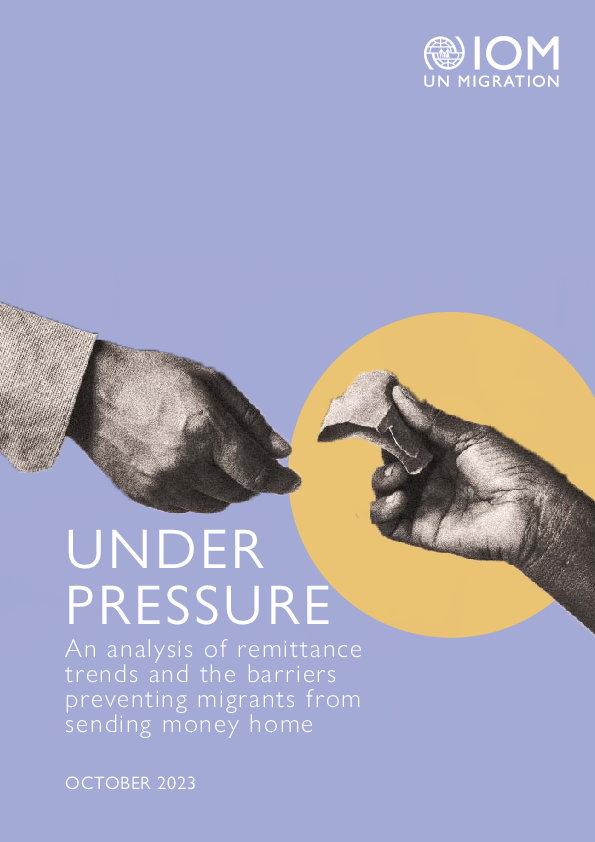
Contact
DTM Libya, DTMLibya@iom.int
Language
English
Location
Libya
Snapshot Date
Oct 31 2023
Activity
- Other
This study highlights some of the opportunities and challenges related to remittances, including the trends and patterns of earning, sending and using remittances as well as the barriers migrants face in sending money home. The study found that migrants are generally sending less money home and a quarter are sending money less frequently. At the same time, the proportion of migrants’ families who are relying on remittances as their primary source of income has been on the rise across countries of origin, pointing to increasing hardship and soaring needs.

Contact
DTM Libya, DTMLibya@iom.int
Language
English
Location
Libya
Period Covered
May 01 2023
Jun 30 2023
Activity
- Mobility Tracking
- Baseline Assessment
IOM Libya’s Displacement Tracking Matrix (DTM) programme identified a total of 704,369 migrants from over 43 nationalities in the 100 Libyan municipalities during round 48 of data collection (May - June 2023). The number of migrants in Libya in May and June 2023 has remained relatively stable compared to the previous two rounds of data collection (705,746 migrants, Round 47, March-April 2023 and 706,472 migrants, Round 46, January - February 2023).

Contact
DTM Europe, DTMMediterranean@iom.int
Language
Bosnian, Croatian, Serbian
Location
Bosnia & Herzegovina
Period Covered
Sep 04 2023
Mar 29 2023
Activity
- Flow Monitoring
Ovaj izvještaj pruža uvide u profile, iskustva, potrebe, rute putovanja i namjere migranata koji su u tranzitu kroz Bosnu i Hercegovinu (BiH).
Podaci su prikupljeni od 4. do 29. septembra 2023. IOM je proveo vježbu praćenja ruta u Republici Srpskoj, Kantonu Sarajevo, Posavskom kantonu, Tuzlanskom kantonu, Bosansko-podrinjskom kantonu i Unsko-sanskom kantonu kako bi pratio trendove ulazaka i izlazaka, te modalitete tranzita unutar BiH. IOM je također anketirao 1.028 migranata na aktivnim tranzitnim lokacijama kao što su autobuske stanice i ključne ulazne i izlazne lokacije širom zemlje, kao i u tri tranzitna prihvatna centra u BiH (Lipa, Borići i Blažuj).
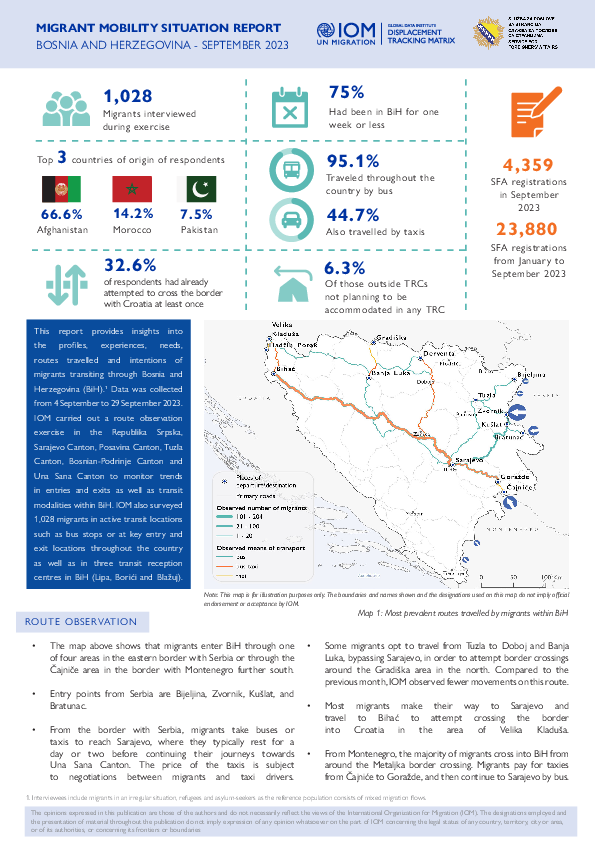
Contact
DTM Europe, DTMMediterranean@iom.int
Language
English
Location
Bosnia & Herzegovina
Period Covered
Sep 04 2023
Sep 29 2023
Activity
- Flow Monitoring
This report provides insights into the profiles, experiences, needs, routes travelled and intentions of migrants transiting through Bosnia and Herzegovina (BiH).
Data was collected from 4 September to 29 September 2023. IOM carried out a route observation exercise in the Republika Srpska, Sarajevo Canton, Posavina Canton, Tuzla Canton, Bosnian-Podrinje Canton and Una Sana Canton to monitor trends in entries and exits as well as transit modalities within BiH. IOM also surveyed 1,028 migrants in active transit locations such as bus stops or at key entry and exit locations throughout the country as well as in three transit reception centres in BiH (Lipa, Borići and Blažuj).

Contact
DTM Iraq, iraqdtm@iom.int
Language
English
Location
Iraq
Period Covered
Aug 01 2022
Oct 31 2022
Activity
- Mobility Tracking
- Baseline Assessment
Climate change and environmental degradation have contributed to the displacement of at least 55,290 individuals in assessed locations in central and southern Iraq between January 2016 and October 2022. This figure represents an estimated 15 per cent of the original population that used to reside in these locations. In other words, more than 1 in 10 people from these locations have been displaced in the past six years. Given the uptick in environmental migration observed in 2022, this trend is expected to worsen, particularly in the absence of adequate mitigation and adaptation strategies.
To better understand the root causes of these movements, the International Organization for Migration’s (IOM) Displacement Tracking Matrix (DTM) developed a tool to assess a location’s vulnerability to climate-induced displacement. The tool measured four dimensions: 1) environmental hazards and water access, 2) services and infrastructure, 3) livelihoods and mitigation measures and 4) tension and conflict. This assessment examined conditions in locations that have already recorded climate-induced displacement, as measured by IOM DTM’s Climate Emergency Tracking tool. Data collection for this assessment took place between August and October 2022 across nine governorates, 29 districts and 262 locations. IOM’s Rapid Assessment and Response Teams (RARTs) collected these data through interviews with key informants (KIs) at the location level. These interviews were triangulated using the normalized difference vegetation index (NDVI) anomaly data, which measure changes in the ‘greenness’ of vegetation cover and are used as a proxy to compare the density and health of vegetation over time. The NDVI anomaly data were extracted from the United States Geological Survey/National Aeronautics and Space Administration (NASA) Landsat remote sensing data and analysed in partnership with the World Food Programme’s Vulnerability and Analysis Mapping team.
This report is based on a survey of displacement patterns, needs and intentions conducted by IOM’s Displacement Tracking Matrix (DTM) in the countries included in the Regional Response Plan for Ukraine in 2023: 6 countries neighbouring Ukraine – Belarus, Hungary, Poland, Republic of Moldova, Romania and Slovakia – and other 5 countries particularly impacted by the arrivals of refugees from Ukraine since the start of the war in February 2022 – Bulgaria, Czechia, Estonia, Latvia and Lithuania. The analysis presented in this report is based on data collected between July and September 2023.
Key Findings:
- Top oblasts of origin: Donetska (15%), Kharkivska (12%), Khersonska (12%), Zaporizka (10%), Dnipropetrovska (7%).
- Intentions to move: Lithuania - no intentions to move (95%), move within current country (1%), or to another country (1%), Top 3 being Poland, Latvia, and the United Kingdom; Latvia - Latvia is a transit country for many refugees from Ukraine. The majority planned to move to another country (58%), Top 3 being Poland, Russian Federation, and Germany. Others wanted to move to a different location in Ukraine (29%), or move to their place of origin in Ukraine (8%); Estonia - no intention to move (88%), move to place of origin in Ukraine (3%), to another country (3%), Top 3 being Germany, Czechia, and Norway.
- Employment status: Lithuania - employed (33%), retired (24%), unemployed and looking for a job (14%), unemployed and not looking for a job (12%), parental leave (12%); Latvia - unemployed and looking for a job (40%), employed (20%), retired (25%), unemployed and not looking for a job (4%), daily workers (3%); Estonia - employed (46%), unemployed and looking for a job (22%), student (14%), retired (6%), on parental leave (5%).
- Top needs*: Lithuania - financial support (27%), health services (22%), medicines (18%), employment (14%), food products (12%); Latvia - housing (36%), cash support (36%), employment (34%), medical needs (23%), information (18%); Estonia - employment (20%), health services (17%), financial support (16%), documentation and registration (12%).
- Top areas of assistance received*: Lithuania - food products (90%), personal hygiene and sanitary supplies (85%), financial support (83%), transportation (58%), clothes and shoes (53%); Latvia - food products (74%), financial support (40%), housing (35%), personal hygiene and sanitary supplies (16%); Estonia - free transportation (84%), food items (71%), financial support (66%), accommodation (34%).
- Top inclusion challenges*: Lithuania - financial issues (23%), language barrier (14%), employment (12%), housing (11%), social services (8%); Estonia - language barrier (33%), employment (24%), housing (14%), accessing social services (9%).
* Multiple answers possible
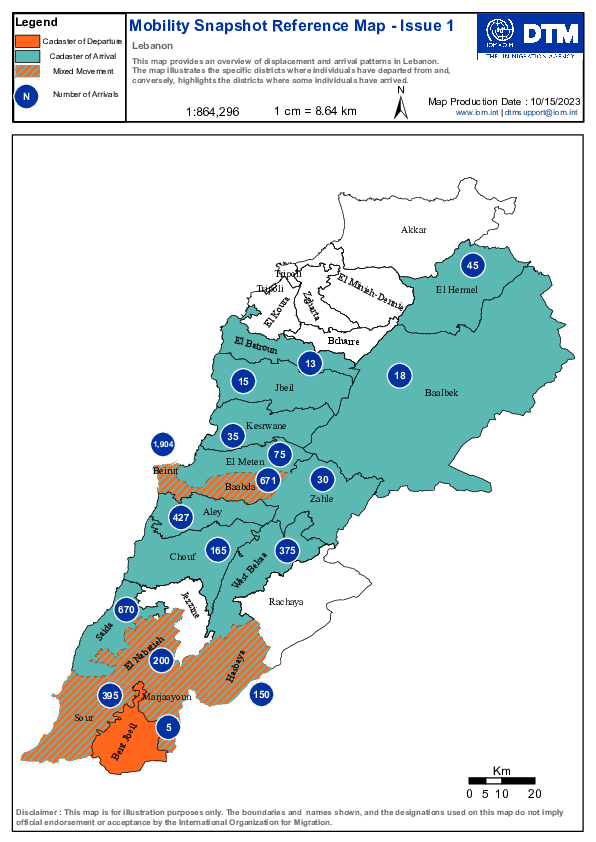
Contact
daibrahim@iom.int
Language
English
Location
Lebanon
Period Covered
Oct 10 2023
Oct 14 2023
Activity
- Mobility Tracking
- Baseline Assessment
Since October 8 there has been an increase in cross-border incidents between Israel and Lebanon, resulting in the displacement of people both within the South and elsewhere within the country. Since October 10, the Displacement Tracking Matrix (DTM) has been conducting the daily monitoring of population movements. The objective of the exercise is to inform preparedness and response planning.
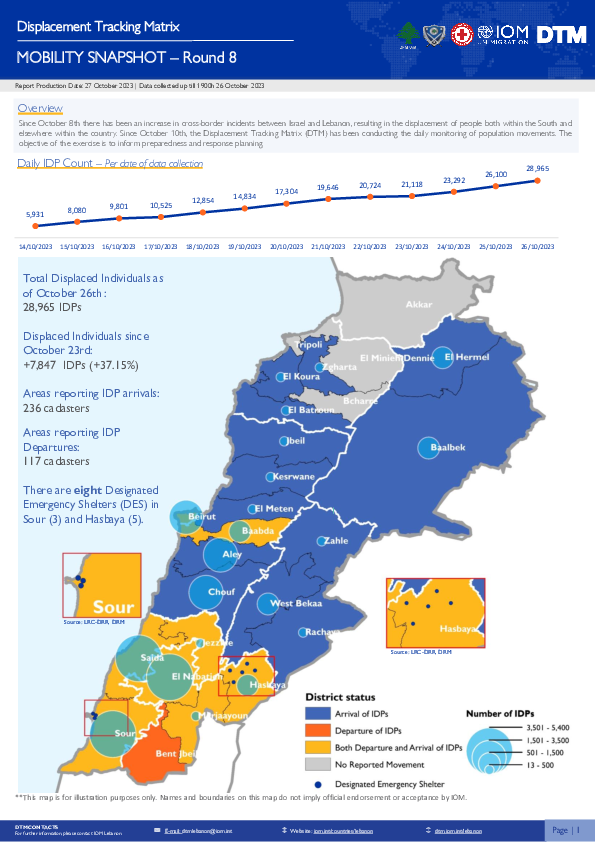
Contact
dtmlebanon@iom.int
Language
English
Location
Lebanon
Period Covered
Oct 10 2023
Oct 26 2023
Activity
- Mobility Tracking
- Baseline Assessment
Since October 8 there has been an increase in cross-border incidents between Israel and Lebanon, resulting in the displacement of people both within the South and elsewhere within the country. Since October 10, the Displacement Tracking Matrix (DTM) has been conducting the daily monitoring of population movements. The objective of the exercise is to inform preparedness and response planning.

Contact
dtmpakistan@iom.int
Language
English
Location
Pakistan
Period Covered
May 01 2023
Jun 30 2023
Activity
- Survey
- Mobility Tracking
- Site Assessment
From June to October 2022, storms and heavy monsoon rains in Pakistan caused widespread flooding and landslides across the country. As of 18 November 2022, according to the National Disaster Management Authority (NDMA), up to 33 million people have been affected by the floods and a total of 90 districts have been labelled by the Government of Pakistan as ‘calamity-hit’.
Between May and June 2023, IOM implemented a third round of the CNI to provide partners with timely information on the displacement situation, the multisectoral needs of the affected population as well as the recovery needs at the settlement level. For this round, IOM implemented the CNI in 10 districts of Khyber Pakhtunkhwa. The CNI was conducted in 3,105 flood-affected settlements or settlements that hosted temporary displaced persons (TDPs) across the 10 targeted districts.
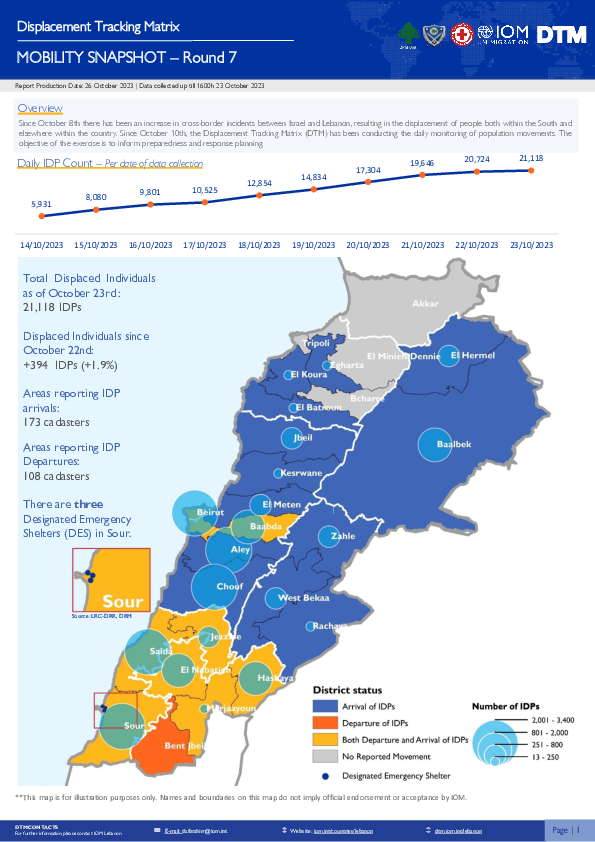
Contact
daibrahim@iom.int
Language
English
Location
Lebanon
Period Covered
Oct 10 2023
Oct 23 2023
Activity
- Mobility Tracking
- Baseline Assessment
Since October 8 there has been an increase in cross-border incidents between Israel and Lebanon, resulting in the displacement of people both within the South and elsewhere within the country. Since October 10, the Displacement Tracking Matrix (DTM) has been conducting the daily monitoring of population movements. The objective of the exercise is to inform preparedness and response planning.
Pagination
- Previous page
- Page 67
- Next page

